Martienssen W., Warlimont H. (Eds.). Handbook of Condensed Matter and Materials Data
Подождите немного. Документ загружается.


732 Part 4 Functional Materials
Table 4.2-23 Typical properties of sintered YBCO according to [2.49]
Flexural strength (MPa) 216 ±16
Young’s modulus (GPa) 141.8 ( = 87%); 180–200 ( = 100%)
Fracture toughness, K1c (MPa m
1/2
) 1.07±0.18
Critical flow size (µm) 15
Thermal expansion, 50–450
◦
C(×10
−6
K
−1
) 11.5
Specific heat at 82% theoretical density (J kg
−1
K
−1
)) 431
Thermal conductivity (Wm
−1
K
−1
)) 300 K 2.67 ( = 85%)
77 K
1( = 85%)
Resistivity (µΩ cm) 300 K 670
100 K
220
T
c
(K) 92 (width 1 K)
J
c
(77 K, H =0)(Acm
−2
) 500–1000 ( = 85%)
: bulk density
Table 4.2-24 Superconducting properties (transition temperature T
c
, coherence length ξ, penetration depth λ,GL
coefficient κ, lower critical field H
c1
, upper critical field H
c2
) for YBCO [2.54]
T
c
(K) 92 [2.25]
Coherence length (nm) ξ
0
0.6 [2.50]
0.4 [2.51]
ξ
⊥
0
2.7 [2.50]
3.1 [2.51]
Penetration depth (nm) λ
L
26 [2.52]
90 [2.51]
130 [2.53]
λ
⊥
L
125 [2.52]
800 [2.51]
450 [2.53]
GL coefficient κ
7.6 [2.54]
κ
⊥
37 [2.54]
H
c1
(T) H
c1
53 [2.55]
H
⊥
c1
520 [2.55]
H
c2
(T) H
c2
140 [2.52]
H
⊥
c2
650 [2.52]
Table 4.2-25 Basic material and critical current density relevant parameters for YBCO according to Larbalestier
et al. [2.22]
Material YBCO
Anisotropy 7
T
c
92 K
H
c2
> 100 T (4 K)
H
∗
5–7T(77K)
In-plane coherence length ξ(0) 1.5nm
In-plane penetration depth λ(0) 150 nm
Depairing current density 3×10
8
Acm
−2
(4.2K)
Critical current density ≈ 10
7
Acm
−2
ρ(T
c
) ≈40–60µΩ cm
Part 4 2.2

Superconductors 2.2 Non-Metallic Superconductors 733
Oxygen content (7–δ) in YBa
2
Cu
3
O
7–δ
T
C
(K)
100
80
60
40
20
0
7.0 6.8 6.6 6.4 6.2 6.0
Fig. 4.2-38 Critical temperature T
c
versus oxygen content
7−δ [2.30]
Superconducting Transition Temperature.
For the T
c
versus oxygen-content behavior, a two plateau depen-
dence is observed (first plateau: 6.8 < 7 −δ<7, T
c
not
T
C
(K)
90
85
80
75
70
65
60
55
90
80
70
60
50
40
30
90
85
80
75
70
65
60
55
50
M =Ca M =La
M =Sr
M =Zn
M =Mn
x (YBa
2–x
M
x
Cu
3
O
7–δ
) x (YBa
2
Cu
3–x
M
x
O
7–δ
)x (Y
1–x
M
x
Ba
2
Cu
3
O
7–δ
)
0.0 0.1 0.2 0.0 0.4 0.8 1.2 1.6 0.0 0.1 0.2 0.3
T
C
(K) T
C
(K)
Fig. 4.2-39 T
c
as a function of the substitution of the cations Y, Ba and Cu by selected cations M according to [2.56–60]
actually constant, slight decrease in T
c
with decreasing
(7−δ); second plateau: 6.55 < 7−δ<6.65, T
c
≈56 K)
(Fig. 4.2-38). Complete substitution of yttrium by rare-
earth metals do not show a significant change for
the value of T
c
, with the exception of the lanthanum
(T
c
= 50 K) and praseodym compounds (not supercon-
ducting) (Table 4.2-21). Other dopants on the different
atomic sizes as a general rule show decreasing T
c
values
with increasing substitution rates. Selected examples are
shown in Fig. 4.2-39.
Critical Current Density. The critical current den-
sity J
c
(B) of YBCO thin films at three different
temperatures as a function of the magnetic field B
⊥c
and
B
c
is given in Fig. 4.2-40. At temperatures T ≤ 60 K
the maximum of J
c
(B) occurs when the magnetic field
is aligned along the film plane. At T = 77 K Roas
et al. [2.61] observed higher J
c
values at B < 2T
and a crossover of the curves perpendicular and par-
allel to the film plane. The crossover seems to depend
on microstructural features, e.g., defect concentration,
twin-boundary distance etc.
Hole Concentration. The oxygen content of YBCO
(YBa
2
Cu
3
O
7−δ
) determines the hole concentration in
the CuO
2
-planes. As shown by Breit et al. [2.62] the
maximum value of T
c
is achieved at an oxygen content
of 7 −δ =6.94 (see Fig. 4.2-41). This maximum is due
Part 4 2.2

734 Part 4 Functional Materials
42 K
60K
77 K
B
⏐⏐c
(θ =0°)
B
⊥c
(θ =90°)
10
7
10
6
10
5
8901234567
Critical current density(A/cm
–2
)
Magnetic field (T)
Fig. 4.2-40 Critical current density with B
⊥c
and B
c
at
various temperatures in magnetic fields up to 8 T according
to [2.61]
T
C
(K)
Oxygen content 7–δ
92
91
90
89
88
87
6.85 6.90 6.95 7.00
Fig. 4.2-41 T
c
as a function of the oxygen content 7 −δ
in YBa
2
Cu
3
O
7−δ
according to [2.62] (data from neu-
tron scattering experiments: ◦ [2.62], [2.63]; data from
normal-state resistivity: +[2.64,65]). The line is a guide to
the eyes
to an optimum hole doping of the CuO
2
planes. At an
overdoped state 7 −δ>6.94, T
c
decreases as the holes
in the planes exceed the optimum concentration.
Lower Critical Field. Figure 4.2-42 presents the tempera-
ture dependence of the lower critical field H
c1
parallel
0 0.2 0.4 0.6 0.8 1
6
4
2
0
1000
800
600
400
200
0
a)
b)
t = T/T
c
H
c1
||
/H
c1
H
c1
(Oe)
||c
⊥c
Fig. 4.2-42a,b Temperature dependence of H
c1
(a) and of
the anisotropy ratio H
||
c1
/H
⊥
c1
(b) according to [2.66]
and perpendicular to c. The anisotropy of the H
c1
is
temperature-independent. The temperature dependence
of H
c1
is in good agreement with BCS calculations
(solid lines in Fig. 4.2-42a) as shown by Wu and Shrid-
har [2.66]. The authors obtained H
||
c1
(0) = 850 ±40 Oe
and H
⊥
c1
(0) = 250 ±20 Oe.
Upper Critical Field. The upper critical fields H
c2
in
high-T
c
superconductors give information about mi-
croscopic parameters, e.g., the coherence length and
their anisotropies in the superconducting state. The
temperature dependence of the upper critical field
H
c2
(T ) for H
⊥c
and H
c
measured on a polydomain
sample [2.67] is given in Fig. 4.2-44. A linear depen-
dence is observed for both directions with slopes of
the critical field of −1.9and−10.5TK
−1
for H
c
and H
⊥c
, respectively. The same dependence meas-
ured by the resistivity method is shown by the dashed
lines. Corresponding to these measurements one can
calculate: H
||
c2
(T = 0K) = 122 T, H
⊥
c2
(T = 0K) =
674 T, ξ
||
0
= 3.0Å,andξ
⊥
0
= 16.4Å.
In low magnetic fields a region of nonlinear depen-
dence of the upper critical field is observed, which could
not be reproduced in monodomain crystals.
Pinning Mechanisms. In high J
c
value melt-processed
YBCO samples, many defects – such as twin planes,
Part 4 2.2
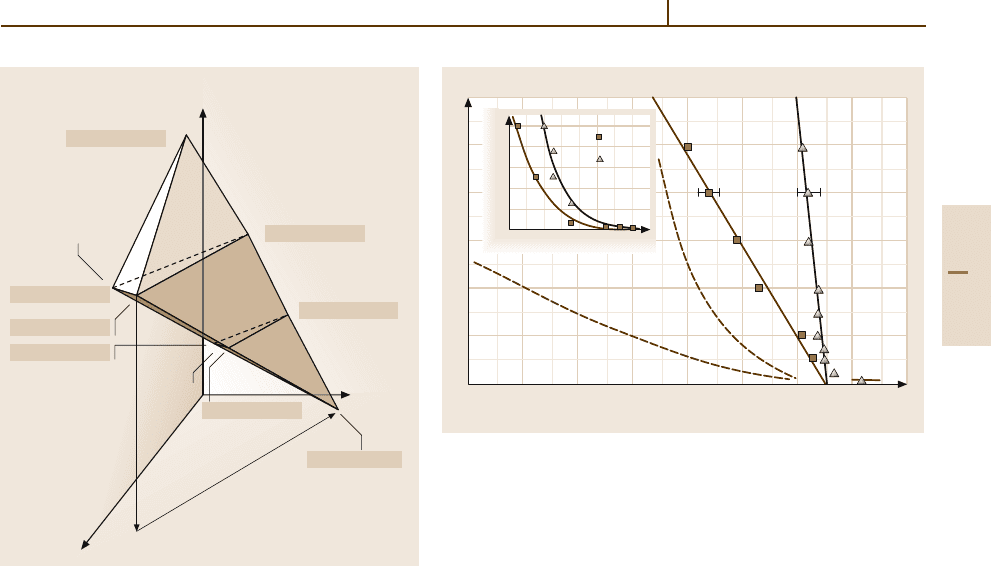
Superconductors 2.2 Non-Metallic Superconductors 735
T (°C)
x Bi
x Pb
850°C
800°C
750°C
Bi:Pb =1.99:0.19
Bi:Pb =1.91:0.36
Bi:Pb =1.84:0.36
Bi:Pb =1.90:0.16
Bi:Pb = 2.08:0.19
Bi:Pb = 2.13:0.18
Bi:Pb = 2.2:0.05
Bi:Pb = 2.03:0.22
Fig. 4.2-43 Schematical three-dimensional representation
of the single-phase region of the Bi2223 phase, the variables
being the temperature and the Bi and Pb contents [2.68]
stacking faults, grain boundaries, cracks, oxygen de-
fects, dislocations or non-superconducting particles –
can act as pinning centers.
Twin planes are usually introducted into YBCO
crystals at the transformation from tetragonal to or-
thorhombic symmetry. The twin planes only act as
effective pinning centers, when the fluxoids are aligned
parallel to the twin plane while the Lorentz force
acts perpendicular to the plane. Twin planes are not
dominant pinning centers in melt-processed YBCO
samples.
Stacking faults. If extra CuO layers are inserted ad-
jacent to the chain plane of YBCO, this tends to a local
structure of the defects resembling that of the so-called
Y124 phase. These may act as important pinning centers
for H
⊥c
, but are not important for H
c
. From a prac-
tical point of view these are not suitable pinning centers
as it is no possible to prepare samples with or without
stacking faults.
Oxygen defects. Däumling et al. observed a peak in
the magnetization hysteresis in oxygen-deficient single
crystals at an intermediate field, which they ascribed to
flux pinning. This kind of pinning center is not the most
important one.
1.0
0.8
0.6
0.4
0.2
0.0
T(K)
H
c2
(T)
6
5
4
3
2
1
0
T(K)
91.0
92.0
85 86 87 88 89 90 91 92 93
B⏐⏐c
– 1.9T/K
B⏐⏐ab
– 10.5T/K
B⏐⏐c
B⏐⏐ab
Fig. 4.2-44 Temperature dependence of the upper critical field
(solid line: magnetization measurements, dashed line: resistive mea-
surements) [2.67]
Cracks. As mentioned above, the tetragonal to or-
thorhombic phase transition associated with oxygen
addition causes stresses in YBCO samples leading to
cracks in the c-direction. These cracks can contribute in
flux pinning as in the case of twin planes or stacking
faults.
Dislocations. In as-grown thin films, many screw
dislocations may occur, which can act as pinning cen-
ters.
Nonsuperconducting inclusions in YBCO may be
effective in flux pinning. Especially the influence of the
211-phase (or 422-phase in the case of Nd-123) is dis-
cussed. Such inclusions are stable and can be dispersed
in a controlled pattern.
Application of YBCO Superconductors. Applications
of YBCO high-T
c
superconductors are superconduct-
ing quantum interference devices (SQUIDS), magnetic
shielding devices, infrared sensors, analog signal pro-
cessing devices, microwave devices, and medical
imaging systems. Since melt-textured bulk YBCO ma-
terial shows magnetic pinning properties, a possible
application may be high-field permanent magnets. For
flexible tape conductors the YBCO material is coated
onto metallic carrier tapes. Conductors coated with
YBCO are studied intensively, because of the poten-
tially high J
c
values in high magnetic fields at T = 77 K.
Typical architectures of these coated conductors are
sequences of polycrystalline metallic substrate or
biaxially-textured metallic substrate – biaxially-textured
Part 4 2.2

736 Part 4 Functional Materials
Table 4.2-26 Present status of Y based coated conductors according to Yamada and Shiohara [2.69] (IBAD: Ion-beam-
assisted deposition, RABiTS: Rolling assisted bi-axially textured substrates, PLD: Pulsed laser deposition, TFA-MOD:
Trifluoroacetate–metal organic deposition)
Material YBCO
Typical Process IBAD, RABiTS, PLD, TFA-MOD
Structure Hastelloy (SUS) / oxide buffer / YBCO layer, monofilament
J
c
1–2MAcm
−2
I
c
−100 A (77 K, 0 T)
Non-SC/SC ratio 100
Length achieved 46 m (reported by Fujikura, Japan AS, Jan. 2003)
Wire configuration Flat tape with thin YBCO layer
Reinforcement Hastelloy, SUS substates
Application Tested –
Remarks R&D stage for 77 K, high field
buffer layer – biaxially-textured superconducting YBCO
layer – Ag stabilizer. The texturing is achieved by rolling
and recrystallization.
Wafers of YBCO thin films are prepared for mi-
crowave applications. Thermal coevaporation is used as
the commercial deposition method. With this method
substrates of about 20 × 20 cm
2
can be coated at rates
of 20–30 nm/min. A double-sided deposition can be
achieved in two deposition steps. The sol–gel method
as well as the chemical solution deposition method are
promising with respect to lower production costs. De-
tailed information on applications is given in [2.81]
(Table 4.2-26)
Table 4.2-27 Structural data of superconducting compounds in the Bi
−
Sr
−
Ca
−
Cu
−
O system and of Pb substituted
Bi2223 [2.15]
Compound Space group Lattice parameters
a (nm) b (nm) c (nm)
Bi
2
Sr
2
CuO
6
Cmmm 0.5361 0.5370 2.4369
Bi
2
Sr
2
CaCu
2
O
8
Fmmm 0.5408 0.5413 3.081
Bi
2
Sr
2
Ca
2
Cu
3
O
10
Fmmm 0.539 0.539 3.71
(Bi
1.6
Pb
0.4
)Sr
2
Ca
2
Cu
3
O
10
Fmmm 0.5413 0.5413 3.7100
Table 4.2-28 Maximum T
c
and a compilation of several values of the coherence lengths, London penetration depths and
upper critical fields at T = 0 K for superconducting compounds of the Bi
−
Sr
−
Ca
−
Cu
−
O system
Parameter Bi2201 Bi2212 Bi2223 Pb-doped Bi2223
T
c
(K) 34 [2.70]
a
90 [2.71]
a
110.4 [2.72]
d
109 [2.73]
c
ξ
ab
(0) (nm) 3.5–4.5 [2.74]
b
4.0 [2.75]
a
≥1.09 [2.76]
a
–3.8 [2.77]
a
2.9 [2.78]
c
2.9 [2.73]
c
≈ 1 [2.79, 80]
e
.
4.2.2.3 Superconductors Based
on the Bi–Sr–Ca–Cu–O System
General Properties
Three superconducting phases exist in the Bi
−
Sr
−
Ca
−
Cu
−
O (BSCCO) system: Bi
2
Sr
2
Ca
2
Cu
3
O
10
(abbrevi-
ated using the stoichiometric coefficients as Bi2223),
Bi
2
Sr
2
CaCu
2
O
8
(Bi2212), and Bi
2
Sr
2
CuO
6
(Bi2201).
A review about phase diagram studies in the sys-
tem Bi
−
Pb
−
Sr
−
Ca
−
Cu
−
O, particularly in view of
the superconducting compounds, is given in [2.68].
The Bi2212 phase is thermodynamically stable over
a relatively wide temperature range. By contrast, the
Part 4 2.2
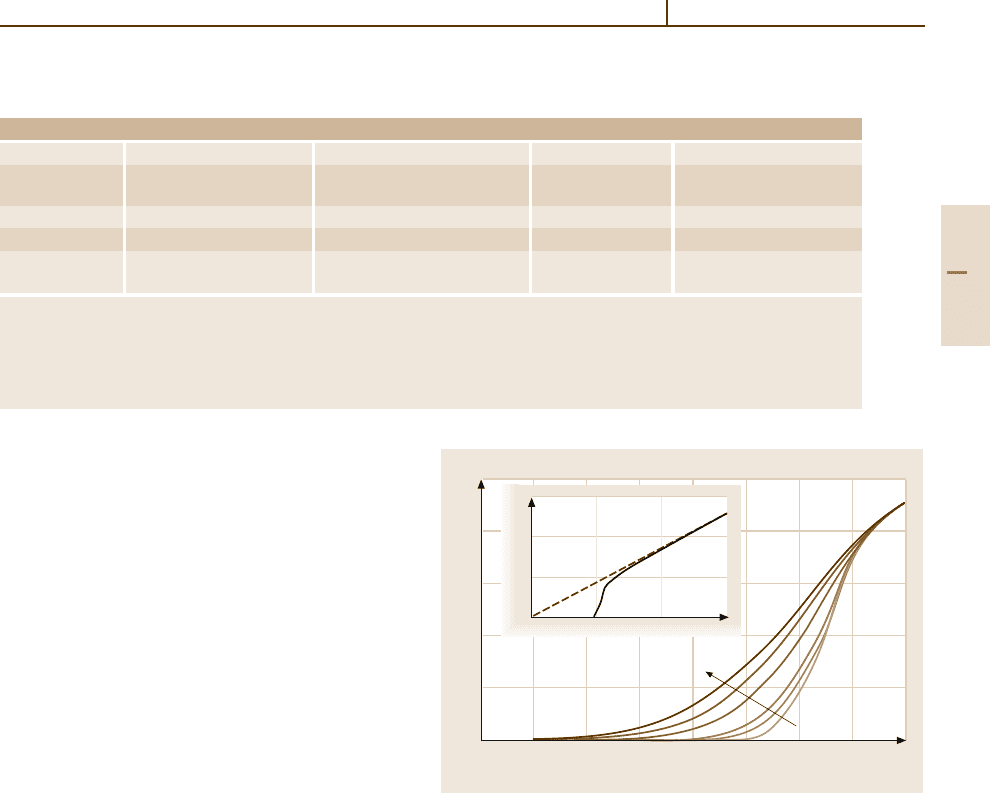
Superconductors 2.2 Non-Metallic Superconductors 737
Table 4.2-28 Maximum T
c
and a compilation of several values of the coherence lengths, London penetration depths and
upper critical fields at T = 0 K for superconducting compounds of the Bi
−
Sr
−
Ca
−
Cu
−
O system, cont.
Parameter Bi2201 Bi2212 Bi2223 Pb-doped Bi2223
ξ
c
(0) (nm) 1.5 [2.74]
b
0.16 [2.77]
a
0.093 [2.78]
c
0.02 [2.80]
e
λ
ab
(0) (nm) 310 [2.82] 438 [2.75]
a
180 [2.83]
a
–310 [2.84]
a
165–230 [2.72]
d
≈ 250 [2.73]
c
, [2.15]
194 [2.79]
e
λ
c
(0) (nm) 1×10
4
–4× 10
4
[2.85]
B
c2(ab)
(0) (T) 43 [2.74]
b
533 [2.77]
a
1210 [2.78]
c
B
c2(c)
(0) (T) 20.2 [2.75]
a
16–27 [2.74]
b
60 [2.86]
a
;70
b
39 [2.78]
c
297 [2.79]
e
Types of the investigated samples
a
Single crystal
b
Overdoped single crystal
c
Whisker
d
Thin film
e
Textured Ag-sheathed tape
Bi2223 phase is stable only over a narrow tem-
perature and concentration range. Considering the
preparation of Bi2223 materials, it has to be noted
that small variations in concentration and/or tempera-
ture can result in quite different phase compositions
and in a significant decrease of the volume content
of the Bi2223 phase. The latter exhibits an excess
of the Bi content of about Bi
2.5
. The formation of
the Bi2223 phase is significantly promoted by partial
substitution of 20–30% Pb for Bi. Figure 4.2-43 rep-
resents the single-phase region of the BiPb2223 phase
schematically. The BiPb2223 phase contains an excess
of Bi +Pb concentration of about (Bi, Pb)
2.2
.Are-
view of the synthesis of bismuth cuprates is given
in [2.16].
As shown in Fig. 4.2-16 of Sect. 4.2.1, the Bi super-
conductors have a layered perovskite structure which
is composed of superconducting CuO
2
/Ca stacks (one
stack in Bi2201, two stacks in Bi2212, and three in
Bi2223) sandwiched between insulating BiO and SrO
planes. The structural data of the compounds are pre-
sented in Table 4.2-27.
Due to this layered structure, the compounds exhibit
a more or less pronounced anisotropy of the electrical
parameters (Table 4.2-28).
Here, λ
ab
and λ
c
are the London penetration depths
for a magnetic field in the c-direction and parallel to
the ab-plane, respectively. B
c2(c)
and B
c2(ab)
are ap-
proximate upper critical fields aligned in the c-direction
and parallel to the ab-plane, respectively; ξ
c
and ξ
ab
are
the coherence lengths in c-direction and in the ab plane,
respectively. Considerably different values have been re-
ported for the parameters listed in Table 4.2-28. This is
true in particular for H
c2
and also for ξ, which is usually
300
200
100
0
100
80
60
40
20
0
0
100
40 50 60 70 80 90 100 110 120
Temperature (K)
Resistivity (µΩ cm)
200 300
B
⏐⏐c
7T
0T
Fig. 4.2-45 Resistivity of a Bi2223 film as a function of the mag-
netic field aligned parallel to the c axis [2.87]
derived from H
c2
. The scatter may bepartly due to differ-
ent chemical composition (doping) and type of samples
(e.g., thin film, single crystal, polycrystalline textured
bulk material). Furthermore, different methods of mea-
suring, e.g., in the case of H
c2
, magnetization M(T ) and
resistive measurements ρ(T ), respectively, were used
and various theoretical models were applied for the
determination of the parameters at T = 0 K. Different
criteria were also used for the resistive determination
of H
c2
: ρ(T ) = 0andρ(T ) = 0.5ρ
n
, respectively. Here
ρ
n
is the normal state resistivity near T
c
.Sovaluesof
B
c2(ab)
(0) were determined to 533 T using the criterion
ρ(T ) = 0 and to 2640 T using the criterion ρ(t) = 0.5ρ
n
for one and the same sample [2.77]. These high values
Part 4 2.2
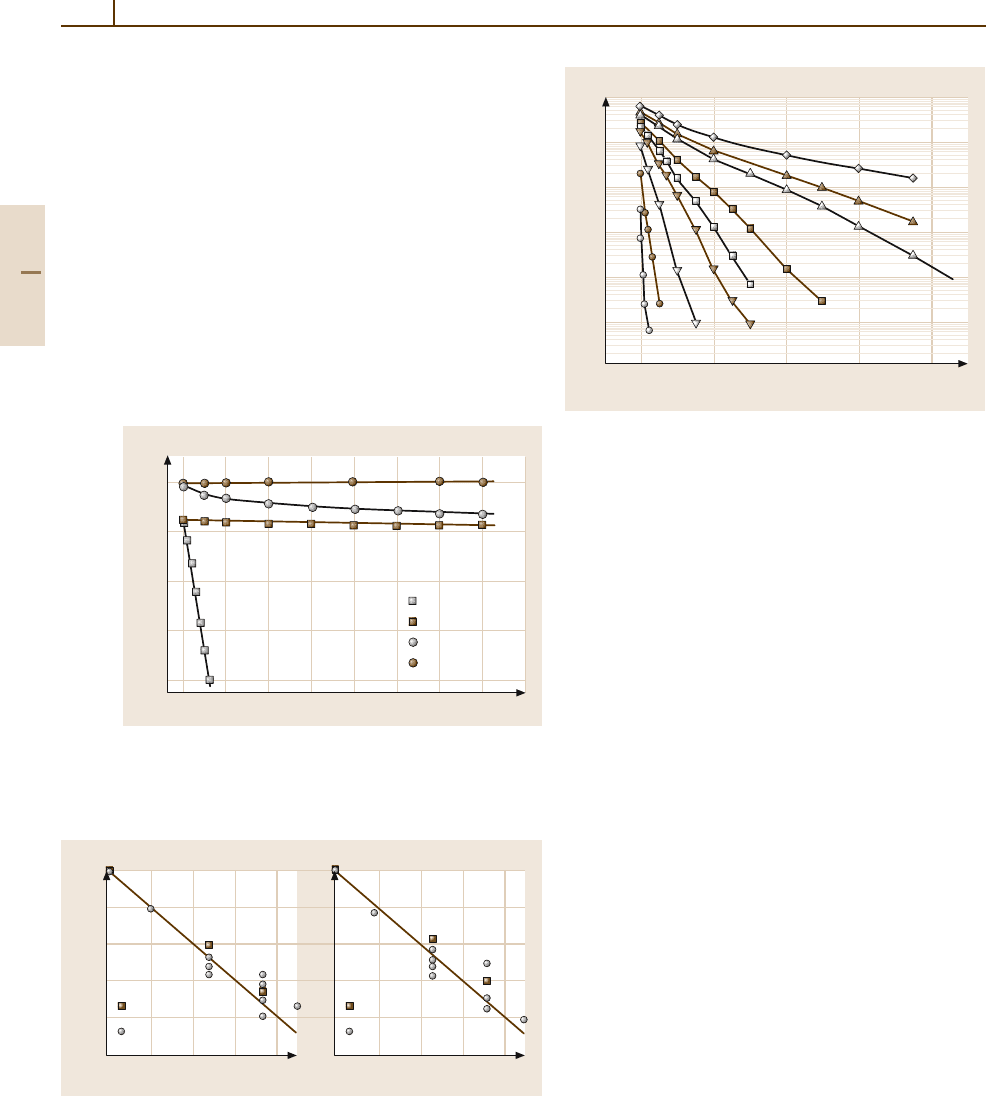
738 Part 4 Functional Materials
are questionable in general, as has been shown in [2.88].
A further compilation of data is given in [2.89].
Thin Films, Single and Bi-Crystals
There are essentially four methods of preparation sup-
plying high quality BSCCO films:
•
Liquid phase epitaxy (LPE) [2.92]
•
Chemical vapor deposition (CVD) [2.93]
•
Ion sputtering [2.94]
•
Pulsed laser deposition (PLD) [2.90]
Epitaxial deposition on monocrystalline ceramic sub-
strates such as Sr
2
TiO
3
or MgO is used to prepare
monocrystalline films. Investigation on the influence of
grain boundaries on the superconducting properties of
10
0
10
–1
10
–2
10
–3
10
–4
01234567
B (T)
J
c
(B, T)/J
c
(0, 2.4)
T=60K, B
⏐⏐c
T=60K, B
⊥c
T=4.2K, B
⏐⏐c
T=4.2K, B
⊥c
Fig. 4.2-46 Magnetic field dependence of the critical cur-
rent density of an epitaxial Bi2212 film for the B
c
and
B
⊥c
directions at 4.2 K and 60 K, respectively. J
c
(0, 4.2) is
the critical current density at 4.2 K in zero field [2.90]
J
c
(θ)/J
c
(0°)
0 10203040
10
–1
10
–3
10
–5
Tilt angle θ (deg)
YBa
2
Cu
3
O
7–δ
0 10203040
Tilt angle θ (deg)
Bi
2
Sr
2
CaCu
2
O
8+x
YBa
2
Cu
3
O
7–δ
Bi
2
Sr
2
CaCu
2
O
8+x
J
c
(θ)/J
c
(0°)
4.2K
77K
Fig. 4.2-48 Ratio of the intergrain, J
c
(θ) and intragrain critical
current densities, J
c
(0), as a function of the misorientation angle θ
for bicrystalline [001]-tilt Bi2223 (circles)andYBa
2
Cu
3
O
7−x
films
(squares) [2.91]
Critical current density(A/cm
2
)
80246
10
7
10
6
10
5
10
4
10
3
10
2
10
1
Magnetic field (T)
B⏐⏐c
20K
26K
30K
40K
45,54K
50K
60K
70K
77K
Fig. 4.2-47 Critical current density J
c
of an epitaxial
Bi2223 film as a function of the magnetic field aligned
parallel to the c axis for the temperature range of
20–77 K [2.87]
the films’ artificial grain boundaries within the films
have been carried out using bi-crystalline substrates.
Critical temperatures up to 91 K [2.91] and
110.4 K [2.72] were measured on Bi2212 and Bi2223
films, respectively. Typical thickness values of such
films are 200–400 nm. An example for the magnetic-
field dependence of T
c
is given in Fig. 4.2-45 [2.87]. In
contrast to the conventional low-T
c
conductors, the onset
temperature of the superconducting transition practi-
cally does not depend on the field and a characteristic
enhancement of the transition width with increasing field
is observed.
Critical current densities on the order of 10
5
Acm
−2
at 77 K in zero field were measured on BSCCO thin
films. In Fig. 4.2-46 the field dependence of J
c
of
a Bi2212 film is shown for two temperatures [2.90] and
Fig. 4.2-47 demonstrates the J
c
(B, T ) dependence of
a Bi2223 film [2.87]. In magnetic fields aligned parallel
to the plane of the film, that is perpendicular to the c axis
of the crystal structure, J
c
is practically independent on
the field strength, even at higher temperatures such as
60 K. The reasons for this behavior are discussed below
in connection with the J
c
(B, T ) correlation of wires and
tapes.
In connection withthe manufacturing of real conduc-
tors of large length the influence of grain boundaries on
the critical current density is of great importance. Inves-
tigations of BSCCO bi-crystalline thin films have shown
that tilt boundaries act as weak links, causing an expo-
nential dependence of J
c
on the misorientation angle, θ,
Part 4 2.2

Superconductors 2.2 Non-Metallic Superconductors 739
similar to the J
c
(θ) dependence of tilt grain boundaries
in YBCO films as shown in Fig. 4.2-48 (compare also
with Fig. 4.2-54 of Sect. 4.2.2.1).
Much effort has been expended to grow BSCCO
single crystals using several methods, such as crys-
tal growth from the melt, fused-salt reactions in
alkali-halide and alkali-carbonate fluxes, respectively,
solid-state reaction, and growth in a gaseous phase. Very
high quality bulk single Bi2212 crystals with a size of
a few mm along the a axis and b axis and about 0.1mm
along the c axis were prepared by the travelling sol-
vent floating zone technique [2.95] or by slow cooling
of the melt below the melting temperature and subse-
quent removing of single crystal fragments from the
ingot by crashing [2.96]. Maximum T
c
values of 90 K
were measured on these crystals. The critical current
densities of such crystals were very small, on the or-
der of 100 A cm
−2
at 77 K in zero field probably due
to the small density of crystal defects. After irradiation
of the crystals with 2.2-G eV Au ion beams directed
along the c axis at a fluence of 1.0×10
11
cm
−2
,anes-
sential increase of the irreversibility line were observed
at temperatures < 70 K. An enhancement of J
c
by a few
orders of magnitude was also measured at low tempera-
tures of about 30 K in a field of 9 T directed parallel
to the c axis [2.97]. These effects can be attributed to
columnar tracks within the crystal lattice.
It is much more difficult to grow Bi2223 than Bi2212
single crystals. Very small crystals with a phase pu-
rity of 97% Bi2223 and dimensions of 0.1 mm along
the a and b axes and 0.001–0.01 mm along the c axis
could be prepared by the fused-salt reaction method
using a KCl flux [2.98]. The onset temperature of
the superconducting transition was determined by dc
magnetization measurement to 110 K and the transition
width to 5 K. Using the measured magnetization curves
and the “Bean” model, the zero field critical shielding-
current density in the ab-plane of the crystal has been
determined to be 1× 10
6
Acm
−2
at 5 K.
The preparation of bulk Bi2212 bi-crystals pro-
vided the possibility to study the influence of [001]
twist boundaries (c axis twist boundaries) on the super-
conducting properties of Bi2212 conductors [2.95, 96].
Assuming the results can be applied to Bi2223 tapes too,
pieces of single crystals were cleaved. One cleave was
rotated through an angle about the c axis with respect to
the other, and placed atop it. The boundary was formed
in a controlled sintering process. Results showed that the
transition temperature of a bicrystal agreed with that of
the single crystal (the twist angle is not noted [2.96]) and
the ratio of critical current densities at T/T
c
≥0.9 across
the twist junction to that across the single crystal was
unity, independent of the twist angle. However, it has
to be noted that in these experiments the critical current
densities were very low and it is not clear whether the
true J
c
values of the grain boundaries could not be meas-
ured due to the current limiting J
c
of the single crystals.
Bicrystals with an enhanced critical current density after
irradiation with Au-ion beams revealed, at low tempera-
tures, a more than one order of magnitude higher critical
current across the single crystal than that across the 45
◦
twist grain boundary [2.97].
Practical Conductors
Fabrication of Wires and Tapes. The most common
approach used to fabricate practical BSCCO conduc-
tors is the so called “Powder-in-Tube” (PIT) method.
As a first step of PIT precursor, powders of appropri-
ate chemical and phase compositions are produced. In
the case of Bi2212 conductors, usually a mixture of
Bi
2
O
3
, SrCaO
3
, CaO or CaCO
3
, and CuO with the ratio
Bi:Sr:Ca:Cu equal to 2:2:1:2 is calcined at 800–850
◦
C
to remove the residual carbon content. The mixture of
oxides and carbonates can be obtained by alternatively
applying mechanical mixing (e.g. milling), or a sol–
gel process, a co-precipitation method, or spray freeze
drying technique. Beside the oxide/carbonate mixture,
a powder produced by spray pyrolysis of a metal-
nitrate solution with subsequent calcination is often
used as an alternate precursor for BiPb2223 conduc-
tors. Typical BPSCCO(2223) precursor powders exhibit
the concentration ratio of Bi:Pb:Sr:Ca:Cu equal to
(1.7–1.8):(0.3–0.4):(1.9–2.0):(2.0–2.1):3.0, and con-
sist of the Bi2212 phase (major phase, about 70%) and
other phases such as Ca
2
PbO
4
, (Pb, Bi)
3
Sr
3
Ca
2
CuO
x
,
alkali earth cuprates, (Ca, Sr)
14
Cu
24
O
x
,orCuO,de-
pending on the preparation conditions (particularly on
the final heat treatment of the precursor). The chem-
ical and phase compositions of the precursor have
a strong influence on the final properties of the wires
and tapes [2.99].
The further steps of PIT excluding the thermal and
thermomechanical treatments, respectively, are illus-
trated in Fig. 4.2-49. The as-produced powders are filled
into an Ag tube and then swaged and drawn into wires.
Mostly the conductors are produced as multifilamentary
(MF) wires due to their more uniform superconduct-
ing properties and superior behavior with respect to
the mechanical properties compared to monofilamen-
tary conductors. When making MF conductors, pieces
of the monofilamentary wire are bundled into a second
Ag tube and then this composite is swaged and drawn
Part 4 2.2
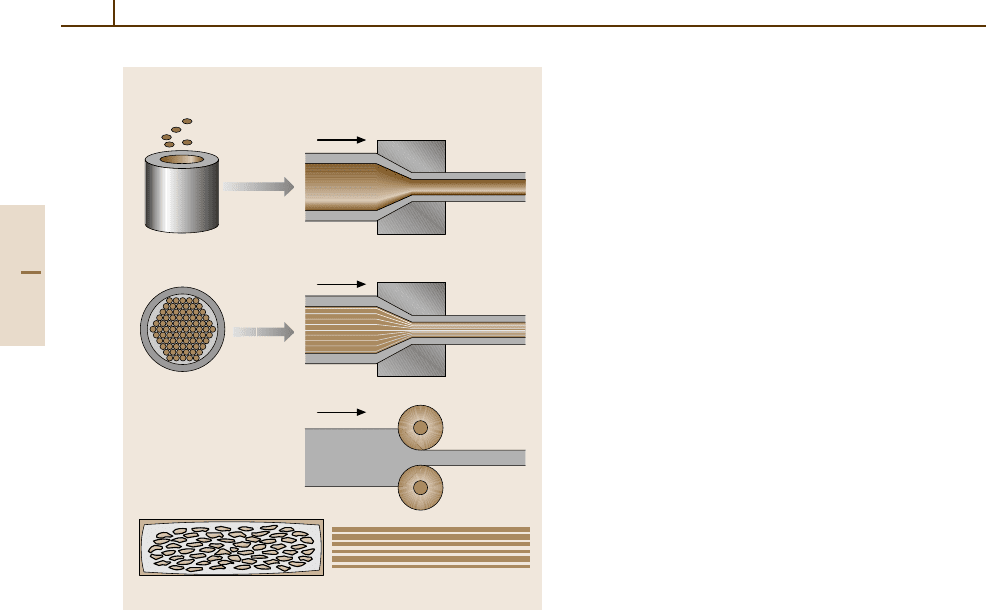
740 Part 4 Functional Materials
Deformation
Drawing
Precursor
Bundling
Rolling
Cross section Longitudinal section
Drawing
Fig. 4.2-49 Scheme of the “powder-in-tube” method, ex-
cluding the thermal and thermomechanical treatments
into wires again. In most cases the wires are finally
rolled into tapes since a higher critical current density
can be achieved for tape-like conductors than for round
wires.
After completion of the deformation process the
Bi2212/Ag and BiPb2223/Ag composites have to be
subjected to a thermal and thermomechanical process,
respectively, in order to transform the Ag-sheathed
precursors into superconducting phases and to real-
ize an optimal microstructure of the superconducting
phase with respect to high critical current densities.
The Bi2212 composites are heated up slightly above the
temperature of partial melting (880–900
◦
C, depending
on the oxygen partial pressure of the annealing atmo-
sphere) and then slowly cooled at a rate of 5–10 K h
−1
to about 830–860
◦
C, followed by holding the com-
posites at this temperature for a few hours. During
this process the Bi2212 phase crystallizes from the
melt as platelets with the crystal c axes aligned per-
pendicular to the wide surface of the platelets. The
microstructure reveals a pronounced degree of texture
with the c axes perpendicular to the filament/sheath
interface.
A more complicated thermomechanical process that
usually contains three steps is needed in the case of the
BiPb2223/Ag composites. At least the first annealing
is performed in a temperature range where a transient
melt occurs, accelerating the conversion of the pre-
cursor into the superconducting phase. The optimum
temperature and dwell time strongly depend on the com-
position of the precursor and oxygen content of the
N
2
/O
2
annealing atmosphere. At a lower O
2
-content
compared to air, lower temperatures and shorter dwell
times are suitable and less dependence of J
c
on the
annealing temperature has been observed. For anneal-
ing atmospheres consisting of the inert nitrogen with
an O
2
content of 7–21%, the optimal temperature is in
the range of 820–835
◦
C, depending on the composition
of the precursor. X-ray diffraction (XRD) investigations
of tapes quenched from different states of the anneal-
ing process as well as in-situ measurements by means
of high-energy synchrotron X-ray diffraction [2.100]
and neutron diffraction [2.101], [2.102], respectively,
have shown that during heating up and dwelling at the
reaction temperature, several reactions such as the in-
corporation of Pb into the Bi2212 phase, the formation
of transient compounds (e.g., (Ca, Sr)
14
Cu
24
O
41
and
Pb
3
(Sr, Bi)
3
Ca
2
CuO
y
) and of a liquid phase mentioned
above precede the real conversion of the Bi2212 into
Bi2223. These reactions are accompanied by the re-
crystallization of the Bi2212 phase and improvement
of its original texture degree, which was caused by the
deformation of the composite into wires and tapes.
During the reaction annealing the density of the
BiPb2223 filaments decreases. Therefore the tapes are
densified after annealing by a compressive treatment,
whereby the electrical connectivity and degree of tex-
ture of the grains are enhanced. Uniaxial pressing is the
most effective method with respect to J
c
. If long tapes
are produced, however, the uniaxial pressing has to be
replaced by rolling. The lower J
c
after rolling, compared
to that after pressing, is probably due to additional mi-
crocracks induced by rolling and can not be recovered
completely by the subsequent annealing which has to
be performed after rolling as well as pressing. Mostly,
a further increase of J
c
can be achieved after a second
compressive treatment and subsequent third annealing.
Figure 4.2-50 shows the longitudinal cross-section
of a BiPb2223 filament embedded in silver. The mi-
crostructure of the superconducting phase in contact
with the Ag sheath reveals a higher density and de-
gree of texture compared to areas in the middle of the
filament. Obviously, Ag influences the conversion re-
action of Bi2212 into BiPb2223. It is known that Ag
Part 4 2.2
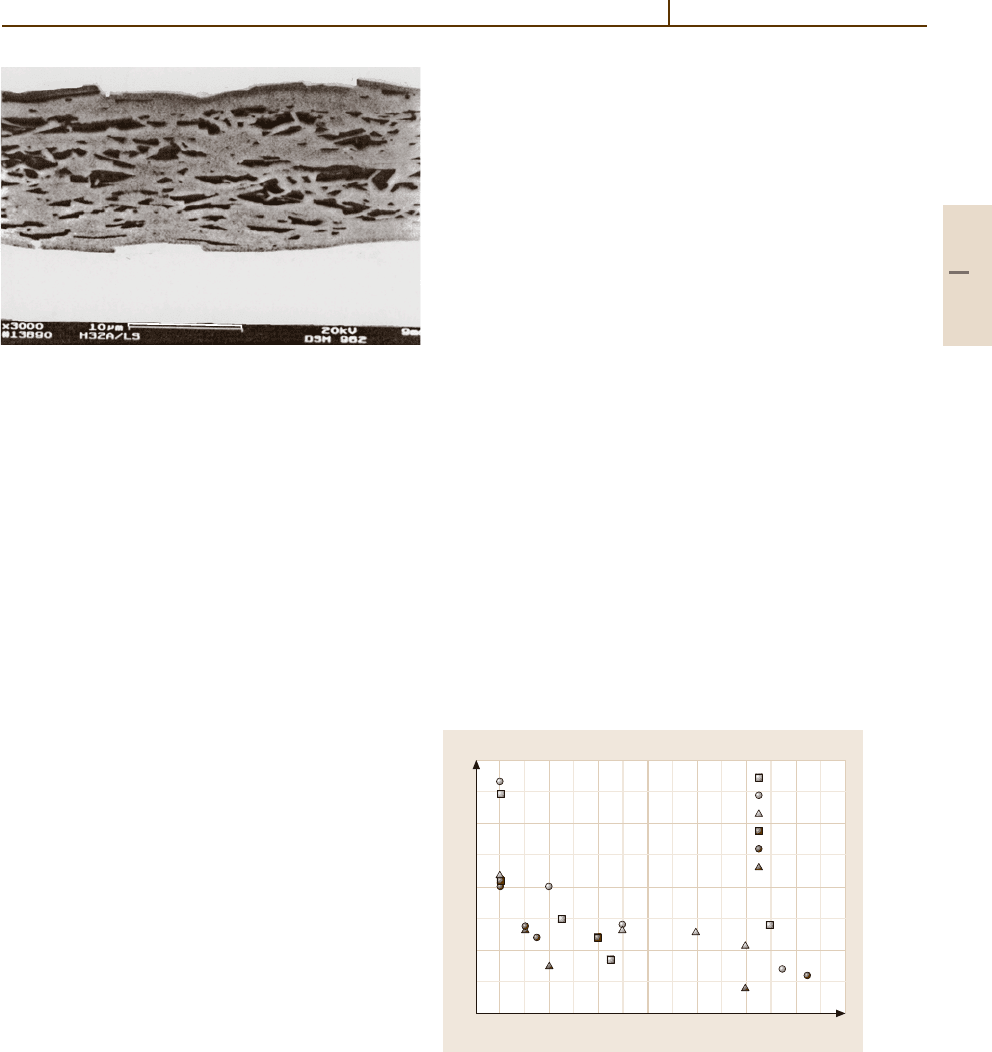
Superconductors 2.2 Non-Metallic Superconductors 741
Fig. 4.2-50 Longitudinal cross section of a BiP2223 fila-
ment embedded in silver
decreases the solidus temperature of Bi2212 [2.103] and
accelerates the BiPb2223 formation process. However,
the reaction mechanism has not yet been fully under-
stood. Two different mechanisms have been proposed:
the nucleation and growth of the BiPb2223 phase from
the melt [2.104] and the formation of the BiPb2223
phase from the Bi2212 grains by intercalation of Ca, Cu,
and O [2.105]. In connection with the first-mentioned
mechanism beside the homogeneous nucleation, the het-
erogeneous one is discussed in [2.102]. In the frame of
the intercalation process, the occurrence of a transient
liquid phase also seems to be an important feature.
In order to improve the tensile strength of the con-
ductors, Ag can be replaced by Ag alloys, such as
Ag
−
Mg and Ag
−
Mn alloys as sheath material con-
taining a few tenths wt% of the alloying element.
Ternary alloys such as Ag
−
Ni
−
Mg are also used. Due
to the respective internal oxidation of Mg and Mn,
during the long-term annealing necessary to form the
superconducting phase, the tensile stress which can
be applied to the tapes without J
c
degradation could
be enhanced from 40 MPa for BiPb2223/Ag tapes
to 90 MPa [2.107] and 130 MPa [2.108] for AgMn-
and AgMg-sheathed tapes, respectively. A high ten-
sile strength protects the conductor against damages
by handling and hoop stresses acting on the conduc-
tor due to the Lorentz force in magnetic coils. Silver
and its alloys are indispensable since no other mater-
ials have been found so far which meet the following
requirements necessary for the construction of practical
conductors: high workability; resistance against oxida-
tion at high temperatures; oxygen permeability since an
exchange of oxygen between the precursor and ambi-
ent atmosphere during the heat treatment is necessary;
no detrimental reaction with elements of the supercon-
ducting phase at high temperatures; and sufficiently high
tensile strength.
Superconducting Properties. The largest efforts with
respect to the production of practical conductors in long
length have been made with BiPb2223 tapes since they
are the most promising conductors for electric power
applications at present. Figure 4.2-51 shows the crit-
ical current density, J
c
, of the superconducting phase
of BiPb2223 tapes, at 77 K in self-field versus the
tape length achieved by various manufacturers [2.106].
With respect to application, the so-called engineering
critical current density, J
e
, defined by the critical cur-
rent, I
c
, divided by the whole transverse cross-section
area (superconductor + sheath) is of great importance.
An example of the performance of long tapes is given
in Fig. 4.2-52, showing J
e
values at 77 K in self-field
for 200-m long tapes produced in one 17 000-m man-
ufacturing run [2.109]. Much higher critical current
densities were measured on experimental short sam-
ples and still higher J
c
values were observed locally
in tapes, demonstrating the potential of BiPb2223 con-
ductors. In Fig. 4.2-53 the steady improvement of J
c
of short multifilamentary samples in the 1990s is
shown [2.110]. Values of about 75 kA cm
−2
at 77 K
and 0 T were achieved [2.111]. Magnetooptical inves-
tigations on a monofilamentary tape with an average
J
c
(77 K, 0T) = 35 kA cm
−2
revealed some small local
regions carrying up to 180 kA cm
−2
(77 K, 0 T) [2.22].
1000 12000 200 400 600 800
80
60
40
20
0
Critical current density (kA/cm
2
)
Length (m)
NST
ASC
Sumitomo
VA C
IGC
MM
Fig. 4.2-51 Critical current densities J
c
of long mul-
tifilamentary BiPb2223/Ag tapes produced by various
manufacturers as a function of the length (NST = Nordic
Superconductor Technologies, ASC = American Super-
conductor Corporation, VAC = Vacuumschmelze, IGC =
Intermagnetics General Corporation [2.106])
Part 4 2.2
